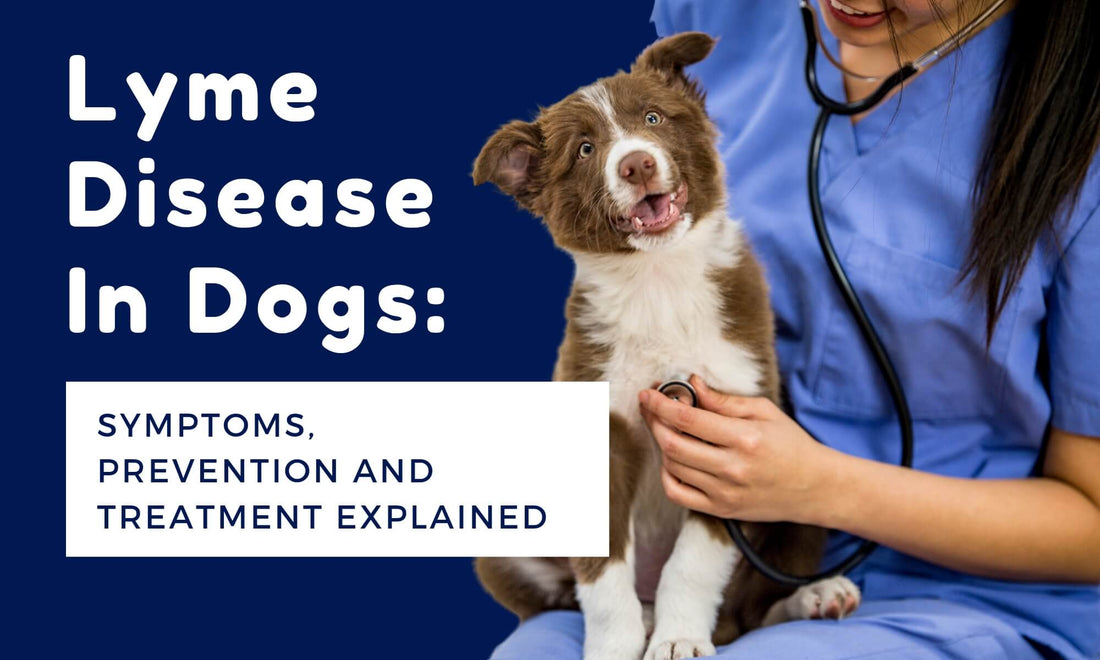Lyme disease, also referred to as Lyme borreliosis, is a bacterial infection that can affect humans, dogs, and various other animals through the bite of specific tick species. The causative agent is the spiral-shaped bacteria known as Borrelia burgdorferi, which resides within ticks and enters the bloodstream of dogs or humans during a tick bite. Once inside the bloodstream, these bacteria can disseminate to different regions of the body, leading to complications in specific organs or areas, including joints, as well as overall illness.
Considering the gravity of Lyme disease, it is crucial to possess knowledge regarding tick prevention and treatment for dogs.
Welcome to our comprehensive guide on Lyme disease in dogs. As passionate dog lovers and experienced professionals in the field, we understand the importance of providing accurate and detailed information to help you protect your furry companions. In this article, we will delve deep into the topic of Lyme disease, covering its causes, symptoms, prevention, and treatment options. Our aim is to equip you with the knowledge you need to effectively manage this potential threat to your beloved pets.
Understanding Lyme Disease
Lyme disease, also known as Lyme borreliosis, is a tick-borne illness caused by the bacterium Borrelia burgdorferi. It primarily affects dogs, humans, and other mammals. This disease is transmitted through the bite of infected ticks, specifically the black-legged tick (Ixodes scapularis) and the western black-legged tick (Ixodes pacificus) in North America.
Where Do Ticks Live?
The ticks harboring Lyme disease tend to inhabit areas abundant with tall grasses, dense vegetation, marshes, and wooded regions, patiently awaiting an opportunity to attach themselves to passing dogs. Once attached, a tick can transmit the disease if it remains on the dog for a span of 24 to 48 hours.
Initially identified following a cluster of cases in Lyme, Connecticut, in 1975, this illness can be challenging to detect and may result in significant and persistent health issues for both dogs and humans.
How Do Ticks Get on People and Dogs?
Ticks lack the ability to jump or fly; their mode of transportation is limited to crawling. These crafty parasites secure themselves onto hosts by strategically positioning themselves at the tips of vegetation. When a dog or a person inadvertently brushes against bushes or similar foliage, the tick seizes the opportunity and promptly attaches itself. Subsequently, it crawls across the host's body in search of a suitable location to bite.
Symptoms and Clinical Presentation
Early detection of Lyme disease is crucial for effective treatment. Being aware of the common symptoms and clinical presentation will help you identify any potential infection. Although some dogs may not exhibit any signs initially, here are the most common symptoms associated with Lyme disease:
Lameness: Dogs affected by Lyme disease may experience recurrent lameness, which can shift from one leg to another. This lameness is often accompanied by joint inflammation and discomfort.
Loss of Appetite: A decreased appetite or complete loss of appetite is a common symptom of Lyme disease in dogs. If you notice a sudden change in your dog's eating habits, it is important to monitor them closely.
Lethargy: Dogs infected with Lyme disease may exhibit lethargy or a general lack of energy. They may seem unusually tired or less enthusiastic about their regular activities.
Fever: An elevated body temperature, often accompanied by shivering and general discomfort, is another indicator of Lyme disease. Regularly monitor your dog's temperature if you suspect an infection.
Swollen Lymph Nodes: Enlarged lymph nodes, particularly those near the site of a tick bite, are commonly observed in dogs with Lyme disease. These swollen nodes may be tender to the touch.
Diagnosis and Testing
If you suspect your dog may have Lyme disease based on the symptoms mentioned above, it is crucial to consult your veterinarian for a proper diagnosis. A comprehensive evaluation and specific diagnostic tests will be performed to confirm the presence of Lyme disease. These tests may include:
Enzyme-linked immunosorbent assay (ELISA): ELISA is a commonly used screening test that detects the presence of antibodies against Borrelia burgdorferi. Positive results indicate exposure to the bacterium, but further testing is required to confirm an active infection.
Western Blot Test: The Western blot test is employed to confirm positive ELISA results. It analyzes the antibodies present in the blood to determine whether the infection is active.
Polymerase Chain Reaction (PCR) Test: PCR testing can detect the genetic material of Borrelia burgdorferi in a dog's blood sample, providing definitive evidence of an active infection.
Treatment and Management
Treating Lyme disease typically involves a combination of antibiotics and supportive care. The primary goal is to eliminate the infection and alleviate the associated symptoms. Here are some key aspects of treatment and management:
Antibiotic Therapy: Your veterinarian will prescribe a suitable antibiotic regimen to combat the Borrelia burgdorferi bacteria. It is essential to follow the prescribed treatment plan diligently and complete the entire course of antibiotics.
Pain Management: To alleviate joint pain and inflammation, your veterinarian may recommend nonsteroidal anti-inflammatory drugs (NSAIDs). These medications can help improve your dog's comfort and mobility during the recovery process.
Supportive Care: Adequate rest and proper nutrition play a vital role in your dog's recovery from Lyme disease. Ensure your pet has a comfortable and quiet environment to rest, and provide a balanced diet to support their immune system and overall well-being.
Tick Prevention: Prevention is key in protecting your dog from Lyme disease. Implementing effective tick control measures is essential. Consider using tick repellents, checking your dog for ticks regularly, and avoiding areas where ticks are prevalent, such as tall grasses and wooded areas.
Vaccination: Talk to your veterinarian about the availability of Lyme disease vaccines in your region. Vaccination can significantly reduce the risk of your dog contracting Lyme disease, providing an additional layer of protection.
Long-Term Outlook and Prognosis
With early detection and appropriate treatment, the prognosis for dogs with Lyme disease is generally favorable. However, it is important to note that some dogs may experience recurring symptoms or long-term complications even after successful treatment. Monitoring your dog closely and seeking veterinary care at the first sign of any issues can help manage the disease effectively.
Preventing Lyme Disease: A Comprehensive Approach
Prevention is the best defense against Lyme disease. Alongside tick control measures, adopting the following preventive strategies can help safeguard your dog's health:
Regular Tick Checks: Thoroughly examine your dog for ticks after spending time outdoors, especially in high-risk areas. Pay close attention to areas where ticks commonly hide, such as around the ears, between the toes, and in the armpits.
Tick Removal: Promptly remove any ticks you find on your dog using fine-tipped tweezers or a tick removal tool. Grasp the tick close to the skin's surface and pull upward with steady pressure to ensure complete removal.
Tick Repellents: Consider using veterinarian-approved tick repellents or spot-on treatments to deter ticks from attaching to your dog. These products are formulated to repel ticks and can be highly effective in reducing the risk of infection.
Environmental Control: Keep your yard well-maintained by regularly mowing the grass, removing leaf litter, and creating a barrier between wooded areas and recreational spaces. This reduces the presence of ticks in your immediate surroundings.
Conclusion
Lyme disease can pose a significant threat to the health and well-being of our canine companions. By staying informed about the causes, symptoms, prevention, and treatment options associated with this tick-borne illness, you can take proactive measures to protect your dog. Remember, early detection, regular veterinary care, and a comprehensive prevention strategy are crucial in ensuring your dog's safety and minimizing the risk of Lyme disease. Stay vigilant, and together, we can keep our furry friends happy, healthy, and free from Lyme disease.
Commonly ask questions about Lyme disease in dogs
Can my dog get Lyme disease from other animals or humans?
No, Lyme disease cannot be directly transmitted from dogs to humans or vice versa. However, humans and dogs can both contract the disease from infected ticks.
How long does it take for symptoms of Lyme disease to appear in dogs?
The incubation period for Lyme disease in dogs can vary, but symptoms typically appear within 2 to 5 months after a tick bite.
Are all dogs equally susceptible to Lyme disease?
No, not all dogs are equally susceptible. Certain factors, such as geographical location and outdoor activity levels, can influence a dog's risk of contracting Lyme disease. Dogs residing in areas with a high tick population are generally at a greater risk.
Can ticks transmit Lyme disease year-round?
While tick activity is more prevalent during warmer months, ticks can be active year-round in certain regions. It is essential to remain vigilant and practice tick prevention measures consistently.
Are there any natural remedies that can prevent Lyme disease in dogs?
While natural remedies may offer some additional protection against ticks, they are not as reliable as veterinarian-approved tick prevention products. It is best to consult with your veterinarian to determine the most effective preventive measures for your dog.
Can Lyme disease in dogs be cured completely?
With appropriate treatment, Lyme disease in dogs can be effectively managed. However, it is important to note that the bacterium that causes Lyme disease can remain in a dog's system even after treatment. Regular veterinary check-ups and proactive preventive measures are essential for long-term management.
Are there any long-term complications associated with Lyme disease in dogs?
While most dogs recover fully with prompt treatment, some may experience long-term complications such as kidney disease, joint issues, or neurological problems. Regular monitoring and ongoing veterinary care are crucial to address any potential complications.
Can indoor dogs get Lyme disease?
Although the risk is generally lower for indoor dogs, it is still possible for them to contract Lyme disease if ticks are brought into the home by humans or other pets. Taking preventive measures, such as regular tick checks and using tick repellents, is recommended for all dogs, regardless of their living environment.
Is there a vaccine available to prevent Lyme disease in dogs?
Yes, there are vaccines available that can help reduce the risk of Lyme disease in dogs. Speak to your veterinarian about the suitability of the vaccine for your dog based on their individual circumstances and geographical location.
Can Lyme disease recur in dogs after treatment?
While rare, Lyme disease can recur in dogs even after successful treatment. It is crucial to monitor your dog for any signs of recurring symptoms and seek veterinary care promptly if needed.
Remember, if you have any concerns or questions about Lyme disease or your dog's health, it is always best to consult with your veterinarian for personalized advice and guidance.



